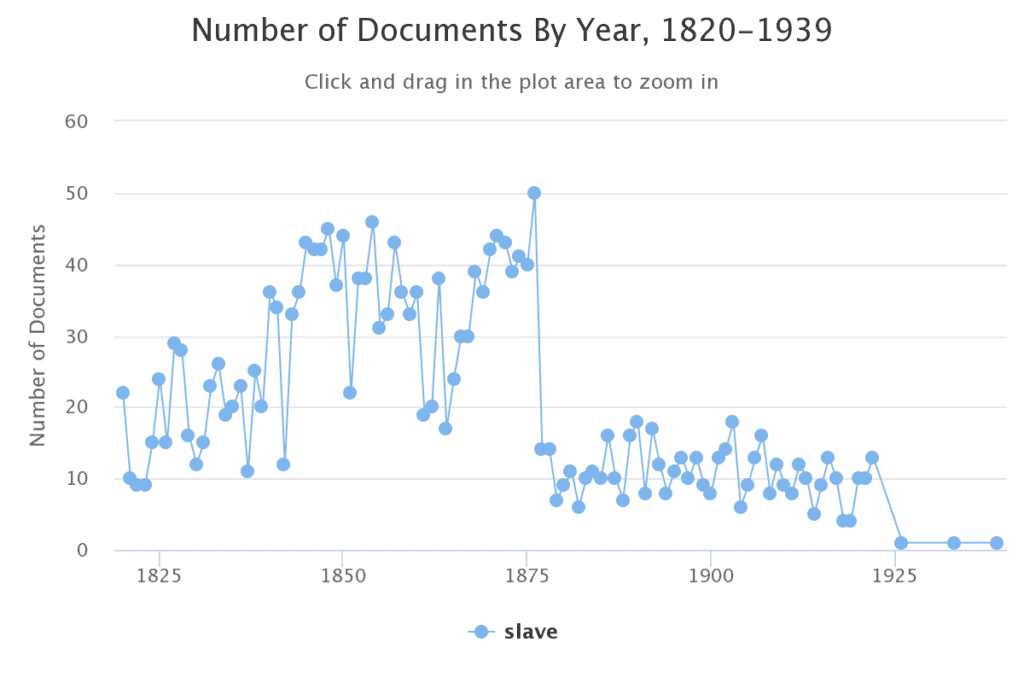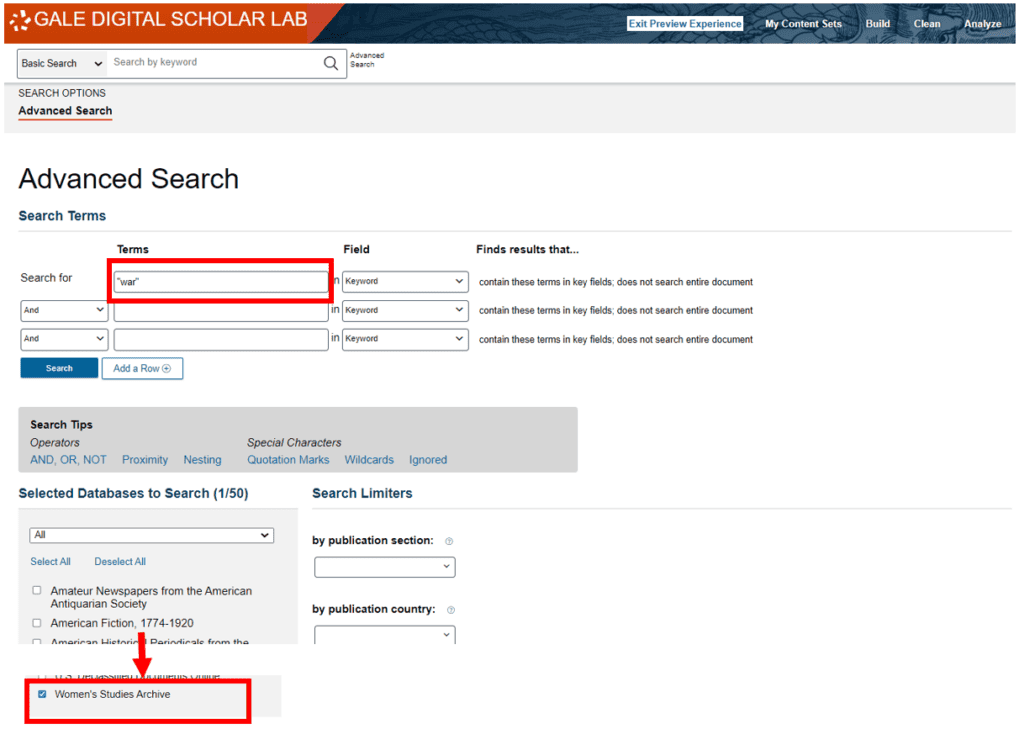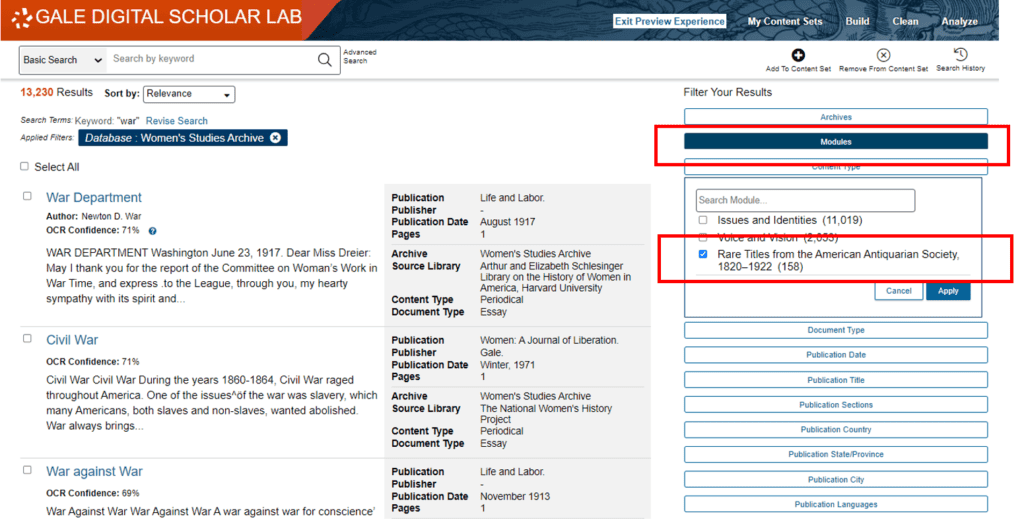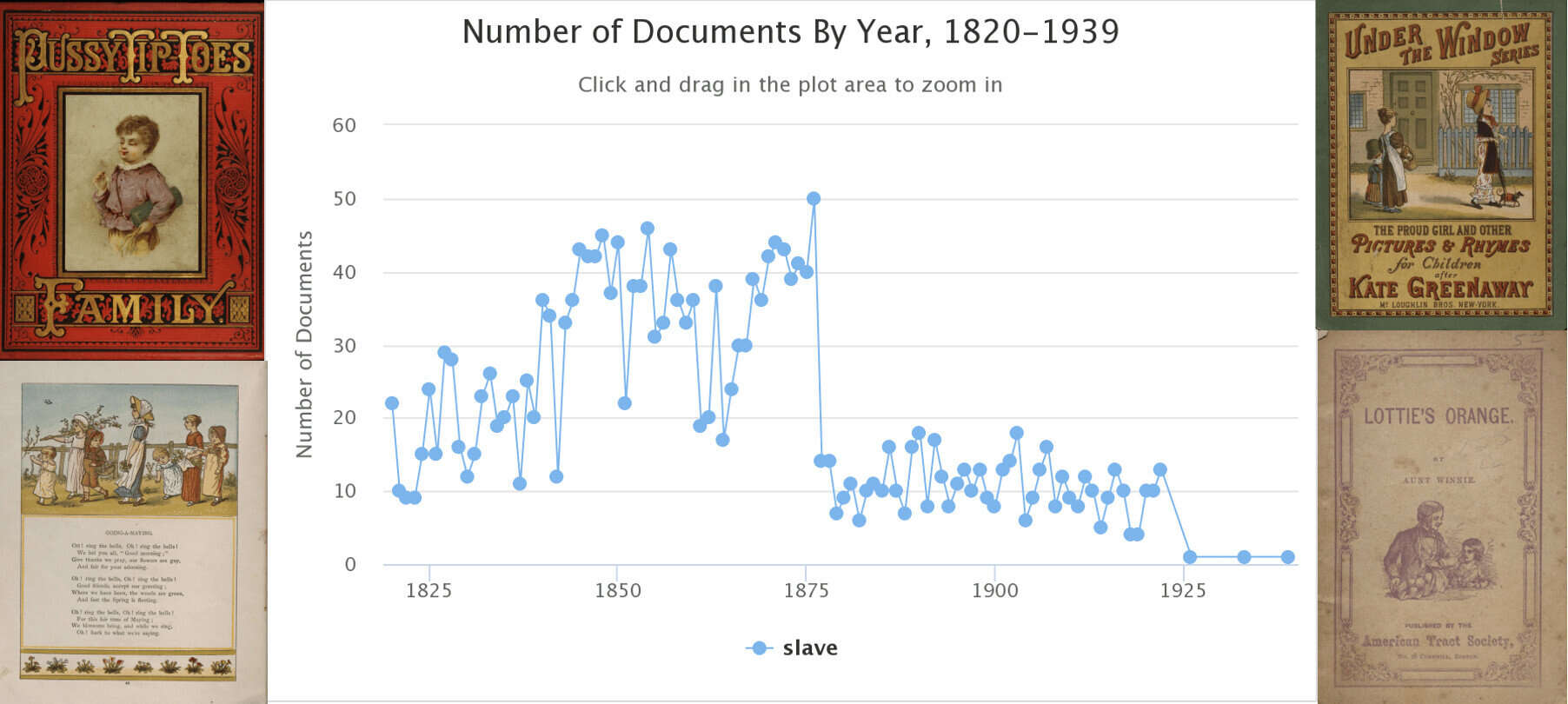│By Rachel Holt, Women’s Studies Archive Acquisitions Editor│
The study of women’s writing is an important cornerstone of any Literature or History course (and many other subjects besides) and Gale seeks to support this important scholarship by working to spotlight female authors. We are doing this in two ways, the first is with the launch of the third part of our multi award-winning Women’s Studies Archive series, Rare Titles from the American Antiquarian Society, 1820-1922, which provides access to over 5,700 monographs by more than 2,000 individual female authors. The second is by introducing a unique new search functionality to the Women’s Studies Archive series, the Author Gender Limiter. The addition of this new product feature opens a world of possibilities for undergraduate study and scholarship in the fields of women’s history, gender studies and beyond.
What is Rare Titles from the American Antiquarian Society?
This new digital archive gives researchers unprecedented access to more than a million pages of female-authored work across a diverse range of fiction and nonfiction. Containing many rare (and some entirely unique) titles from the American Antiquarian Society, this latest offering will enable new scholarship into feminist perspectives and the discovery of previously ignored works that are important to the study of Women’s History, Gender Studies, American and Canadian History, Sociology, Politics, Journalism, and more.
![Greenaway, Kate. The proud girl and other pictures & rhymes for children: after Kate Greenaway. McLoughlin Bros. New-York, [188-?]. Women's Studies Archive, https://link.gale.com/apps/doc/OHRCJR651867392/WMNS?u=webdemo&sid=bookmark-WMNS&xid=de51d54e&pg=1](https://review.gale.com/wp-content/uploads/2021/07/Rachel-Rare-Titles-Gender-Limiter-The-Proud-Girl-1024x661.jpg)
What is the Author Gender Limiter?
As the name might suggest, the Author Gender Limiter tool limits your search to monographs that are authored by a person(s) of the selected gender.
The four limiters currently available within this series are:
- Female
- Male
- Unknown [Alias]
- Unknown
The metadata required to enable this function was initially created by running the author names through software to identify whether the author was Female, Male or Unknown, based on their name and/or epithet. This was an efficient approach to gathering the data, and created a preliminary list, but the process understandably led to some incorrect attributions. For example, well-known pseudonyms, such as George Eliot, were frequently misidentified by the software. As such, Gale manually went through the data set created and checked for any anomalies. Names were checked against our internal database of terms, alongside additional searches, to ensure that the data was as accurate as possible before being included in the archive.
Explaining the category Unknown: [Alias]
At this stage we also added an additional category: Unknown: [Alias]. Unknown [Alias] is here used to indicate authors that we believe are likely to be artificial constructs created by the contemporary publisher. Unlike pseudonyms (such as George Eliot) which are often intended to disguise the author’s identity, Unknown [Alias] is used to give artificial credibility to the writer, or group of writers, often by assuming a specific gender or role. Good examples of this are agony aunt columns, where the title ‘Aunt’ is used to denote comfort and female wisdom and the same name might endure through multiple authors – becoming, in effect, a brand name as much as an Alias. A modern example of this is Slate’s Dear Prudence, where the persona of Prudence covers the work of multiple writers of different genders. We felt that these formed an interesting subset in their own right, and that making them easily identifiable would be beneficial to researchers, particularly those working within the digital humanities.
For the time being, the Author Gender Limiter is only applicable to monographs within two modules of Women’s Studies Archive: Voice and Vision and Rare Titles from the American Antiquarian Society, 1820-1922, although there are hopes to extend this functionality beyond this resource and content type to other Gale digital archive resources.
How Does the Author Gender Limiter Address the Diversity of Gender Identities?
Gale is aware that these limiters currently present a binary approach to gender. Gale is a supporter of the LGBTQIA+ community, and we strive always to be inclusive. However, after much discussion, this decision was taken because it best reflects the nature of the material itself, which currently only includes, as far as we have been able to identify, authors who have self-identified as, or otherwise historically been attributed to, a particular gender based on known information about them. In an effort to prevent non-viable searches we have not included non-binary, gender non-conforming, genderfluid, intersex, or agender limiters at this point in time. We felt that including limiters that yielded no results would be misleading to users and to the people we strive to support. In Gale products, where a gender limiter is provided, we will actively review the limiter options offered to ensure they encompass all author genders identified in the material.
If you notice that an author has been incorrectly classified based on known information about that person, please do let us know! We endeavour to make the Women’s Studies Archive an accurate and inclusive resource and are very happy to make changes to both our metadata and our limiter options to ensure that this remains the case.
Absence from an archive can be meaningful in itself
It is important to recognise however that silences in the archives are meaningful in themselves and can allude to a hidden, historical narrative. Examples of gender non-conformity can be found in cultures worldwide since ancient times, but it has not always been possible to live openly as a non-binary person, or with any gender expression/identity that varies from what a person was assigned at birth. The Women’s Studies Archive primarily concerns eighteenth, nineteenth and twentieth century materials, predominantly from western societies where gender nonconformity could lead to ridicule, violence or incarceration. It is possible that non-binary individuals exist within the archive, but they were not identified or catalogued as such.
Terminology to define non-binary people can sometimes be fairly modern, with many terms originating from the 1980s onwards, so binary genders may have been inappropriately assigned due to an inappropriate vocabulary at that time. It is also conceivable that non-binary authors were discriminated against and their works were not published or collected by traditional avenues. Whether these are the reasons for a lack of non-binary authors in the Women’s Studies Archive is hard to know for certain, but it is important to address why they are not represented. Lack of representation of minorities is an issue for many, if not most, archives and it is important to recognise why the gaps occur so that scholars, teachers, and students can encourage a wider conversation on such issues.
Why Is the Author Gender Limiter Important for Undergraduate Study, Postgraduate Scholarship and Teaching?
The decision to build the Author Gender Limiter was driven by repeated requests from librarians and instructors to Gale’s editorial team for the ability to identify an authors’ gender within our resources. There is a clear research need for this functionality in the fields of women’s history and gender studies to further empower learning and research.
One of the primary goals of the Women’s Studies Archive is to provide female narratives which have historically been underrepresented. The tradition of women writing has often been ignored due to the perceived inferior position that women have held in patriarchal societies. It is still common to find anthologies, taught on courses at Higher Education institutions around the world, in which women are outnumbered by male writers or even entirely absent.
The ability to search within the Women’s Studies Archive using one or more key words and then limit the search by authors of a particular gender enables users to gain a gendered perspective on a particular topic. For instance, a user interested in women and the First World War could do a basic search using the key word “war” and then filter results by the appropriate date range, 28 July 1914 to 11 November 1918, as well as by the authors’ gender so that only female writers appear in the results. Although this is likely to throw up some irrelevant results (e.g. a female author writing about ancient wars, or using the word “war” to describe a campaign they are championing etc.) this should supply the user with a corpus of primary sources that provide a female perspective of the First World War.
Why is studying a topic from the female perspective important? Because women’s history is human history. We cannot understand our past if we cut out the experience, viewpoint, and contribution of half the world’s population. For much of history there has been a wider trend of historians not including women in their accounts of the past. For centuries, history has not only been recorded, told, and taught from a male perspective but women’s part in it has often been downplayed, ignored, or recast to fit a male agenda. Primary sources provide a window into the past by giving insight into how an individual or group experienced the times they were living in, hence why the ability to locate female authored works is so important. Greater access to, and discoverability of, the works of women writers allows for a new viewpoint of history.
![Left: Sanford, D. P. Pussy tip-toes' family: a story for our little girls and boys: By Mrs. D. P. Sanford author of "The Rose Dale books," etc., etc. E. P. Dutton and Company, Publishers 713 Broadway, 1876. Women's Studies Archive, https://link.gale.com/apps/doc/EJGNPM706058635/WMNS?u=webdemo&sid=bookmark-WMNS&xid=66e15f85&pg=1
Right: Winnie. Lottie's orange: By Aunt Winnie. Published by the American Tract Society, 28 Cornhill, Boston, [ca.1876?]. Women's Studies Archive, https://link.gale.com/apps/doc/YCSAZC908495059/WMNS?u=webdemo&sid=bookmark-WMNS&xid=d0fc662e&pg=1](https://review.gale.com/wp-content/uploads/2021/07/Rachel-Rare-Titles-Gender-Limiter-two-titles-1024x702.jpg)
Right: Winnie. Lottie’s orange: By Aunt Winnie. Published by the American Tract Society, 28 Cornhill, Boston, [ca.1876?]. Women’s Studies Archive, https://link.gale.com/apps/doc/YCSAZC908495059/WMNS?u=webdemo&sid=bookmark-WMNS&xid=d0fc662e&pg=1
What Implications Does It Have for Digital Humanities?
Digital Humanities is an area of scholarship applying computer-based technology in the humanities. For researchers, digital humanities scholarship is fuelling new ways of interrogating content, analysing insights, and outputting discoveries. The Author Gender Limiter offers further exciting possibilities, especially the development of feminist digital humanities.
The ability to create a data set of female-authored works within a precise date range or surrounding a particular topic enables greater opportunities to explore women’s writing in new ways. As well as providing a female perspective on a specific event (wars, technological advancements, governments etc.), time periods or topics (education, health and medicine) such data sets support the ability to track the development of female language and ideas.
It is also not as difficult or inaccessible as you might initially think. Undergraduate students or early career researchers can easily use Gale Primary Sources inbuilt tools to interrogate this data further. Researchers can use the Term Frequency tool to see the frequency of search terms within sets of content to begin identifying central themes and assessing how individuals, events, and ideas interact and develop over time. For instance, a user interested in women’s role in the abolition of slavery could search Women’s Studies Archive for the word “slave”, use the Author Gender Limiter to limit the search to women authors and then apply the Term Frequency tool.

This not only shows that women were talking about slavery but creates a visualisation of when this was most and least prevalent as well as for how long for. For instance, in 1876 the word “slavery” appears the most in women’s writing so students looking to write a paper or researchers doing in depth analysis may focus in on those materials. They may also want to consider what else was going on at that time which might have caused this spike, as 1876 experienced not only a presidential election but a summer of race riots in South Carolina.
Users seeking a new angle on a topic for a paper or article can utilise the Topic Finder tool. By grouping commonly occurring themes, this tool reveals hidden connections within search terms—helping to shape research by integrating diverse content with relevant information. If we run the same search again for the word “slave”, limiting results to only women authors and then apply the Topic Finder tool the user is supplied with multiple related themes.

For instance, “women’s rights”, “suffrage” and “woman’s worth” all come up as linking to “slave” so an undergraduate might consider writing a paper or article on the relationship between abolitionism and the women’s rights movement.
Using Rare Titles from the American Antiquarian Society, 1820-1922 in the Digital Scholar Lab
Digital humanists wanting to take their research even further can do so by replicating data sets created using the Author Gender Limiter in Gale Digital Scholar Lab, which enables users to make further discoveries. Alternatively, as Rare Titles from the American Antiquarian Society, 1820-1922 focuses on female writing, scholars pursuing feminist humanities projects have an (almost) ready-made data set of only women’s literature from which to start, so could simply use Rare Titles from the American Antiquarian Society, 1820-1922 within the Gale Digital Scholar Lab. Through the Advanced Search feature in Gale Digital Scholar Lab, a user can select Women’s Studies Archive and then limit by module, allowing them to build a content set from Rare Titles from the American Antiquarian Society, 1820-1922 only.


The benefit of this is that a user has an almost instant data set on a chosen topic. For example, if a user were to conduct a search for the key word “war” in Rare Titles from the American Antiquarian Society, 1820-1922, they would be supplied with a corpus of women’s literature on war. As you can imagine, this will turn up some erroneous results, but it would be a good place to start for any researcher. This could be taken further; if a user were to limit their search by date they could focus in on a specific military conflict such as the American Civil War or the World Wars.
In a nutshell, the Gale Digital Scholar Lab gives the user access to six tools:
- Named Entity Recognition (extracts Named Entities from documents)
- Ngrams (builds collocations of words)
- Parts of Speech (creates a lexicographical index or dictionary of a content set)
- Sentiment Analysis (denotes the degree of positive, neutral or negative feelings via a quantitative scoring system)
- Clustering (identifies groups of documents, based on shared characteristics)
- and Topic Modelling (allows a user to discern patterns).
Just imagine how these could be used to analyse a corpus of women’s literature on war! For instance, by using the Sentiment Analysis tool, users can answer questions such as: what was the sentiments of the word “war” across women’s writing over the last hundred years? Were women largely for or against war and how did sentiments change over time, or following major military events?
Another way the Rare Titles from the American Antiquarian Society, 1820-1922 could potentially be used by digital humanists could be identifying women’s writing. Locating lost female authors is a common objective of many scholars in women’s history. Women, more than men, historically wrote anonymously or under pseudonyms. It has been suggested that studying the linguistic patterns of known women authors in a specific era might enable researchers to identify whether an anonymous writer was likely female – or even identify a specific female author.
Women’s impact or societal contributions have traditionally been seen as secondary to men but how much of this is due to history being predominantly told from a male perspective? Digital Humanities facilitate the ability to re-evaluate accepted histories and review the role and significance of women from the past.
Conclusion
Research into women’s writing and female authorship is unquestionably important and Gale is building resources intended to support and further such scholarship.
The analysis of women’s literature allows us to study a group of people marginalised by history and, through their writing, explore the unique socio-political space that they occupied within their culture. It is not coincidence that there was a boon of women writers in the nineteenth century. This growth correlates to advancements in female education and suffrage as well as a demonstration of women occupying a new authorial space in the public, rather than the private or domestic, sphere. In Virginia Woolf’s famous feminist essay, she argues that women need both a literal and figurative space within a literary tradition dominated by men:
“A woman must have money and a room of her own if she is to write fiction.”
Woolf, V. (1929). A Room of One’s Own. New York, Harcourt, Brace and Company.
The introduction of the Author Gender Limiter to the Women’s Studies Archive series, as well as the showcasing of female authors in Rare Titles from the American Antiquarian Society, 1820-1922 is intended to equip researchers and students with the tools they need to interrogate what, when, where, why, and how women write.
If you enjoyed reading about the Author Gender Filter in Women’s Studies Archive, and its great potential for the study of women’s authorship and Digital Humanities, you may like:
- Teaching Primary Source Research Skills – Discovering New Points of View about European and Colonised Women Using Gale’s New Archive ‘Voice and Vision’
- Introducing ‘Women’s Studies Archive: Voice and Vision’
- Free from Male Influence: The Second Wave Feminist Press
- Birth Control: A History in Women’s Voices

